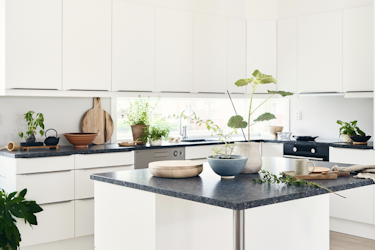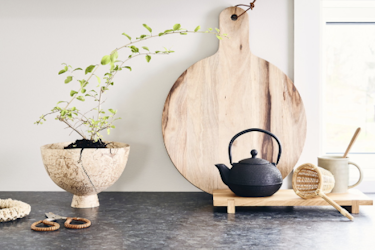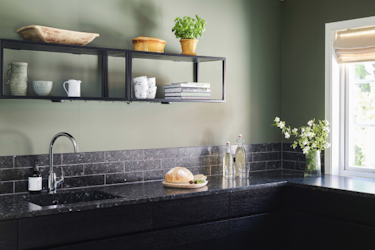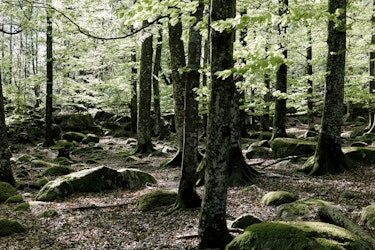
Defined as ‘the innate human instinct to connect with nature and other living beings’, biophilia has become an intrinsic part of interior design. As we crave connection to the outdoors, a desire further heightened by the pandemic, we have seen an increase in everything from plants to natural materials in the home. The benefits of incorporating natural and nature-inspired elements into interiors are of great significance — from supporting our physical health to improving our psychological wellbeing — establishing biophilia as a global trend that will transcend time.
Here we take a look at the numerous ways of achieving the perfect balance between biophilia and design.

Embracing nature through materials
As our attentions turn more and more towards what is good and bad for our planet, our interest in natural materials has grown rapidly. We are no longer blind to the ill effects of man-made and synthetic materials and are learning everyday how opting for 100% natural will have a positive long-term effect.
When it comes to surfaces, you can’t get much better than 100% natural stone. Crafted by nature, its practical benefits match its aesthetic appeal, boasting exceptional resistance to heat, scratches, stains, water and even UV rays. Suitable for kitchen worktops, bathroom countertops, floors and even walls, a 100% natural Lundhs Real Stone surface allows you to connect directly to the outdoors.
From eco-friendly paint to FSC certified wood, nature can be embraced through every element of the home. Seek out wood furniture or finishes that you know are properly certified, to ensure you are making an eco-conscious purchase. The beauty of the natural grain of wood is something that can’t be beat, especially when paired with other natural textures and materials.
Bring in organic textures
Soft furnishings can also provide an organic touch to an interior scheme. Linen is one of the most eco-friendly fabrics — made from flax plant fibres, it is biodegradable and even has a beautiful array of natural colours. From bed linens and cushions to throws and rugs, the interiors industry has boomed with manufacturers using everything from recycled bottles to truly sustainable fibres to create wonderfully natural yet stylish soft furnishings.
Subtle texture can also be incorporated into a design scheme through accessories. Stoneware on tables and in the kitchen in soft matte finishes can add a sculptural element, whilst naturally-blown glassware and vases will add an authentically organic feel.
Incorporating earthy colour palettes
Colour plays an important role in biophilic design. The colours you choose for your walls, floors and surfaces will act as the base for your interior scheme, setting the scene and the atmosphere. You should build your colour palette from this base, and choose to either complement or contrast with similar colours or accent tones.
For an interior that exudes nature-inspired energy, green is the ideal choice. Associated with the great outdoors and prosperity, it’s one of the most versatile shades. From deep sage hues to emerald tones, green has become a common colour choice in interiors, in particular in kitchens and bathrooms, adorning cabinets and walls alike. Combined with plenty of plants and pops of other earthy hues such as terracotta or rust, it is guaranteed to make you feel like you are truly bringing the outside in.

Bringing the outside in through greenery
The houseplant industry has seen a tremendous increase over the past few years. The pandemic in particular left a lot of homeowners craving a connection to the outdoors and plants were the ideal way to bring the outside into our homes. Plants exude a naturally calming atmosphere and having them in your home can be a source of happiness. There is even evidence to suggest that houseplants can have a positive effect on the air quality in your home, meaning that they’re not only good for our mental health and wellbeing but also for the environment we live and breathe in.
---
At Lundhs, our focus on sustainability and affinity to nature forms a core part of our philosophy — it’s about more than just using natural materials, it’s about taking care of the precious resources, utilising all of the surplus material and restoring quarries back to nature, as well as working in accordance with strict environmental regulations and giving back to our people and communities. As suppliers of 100% natural stone, we will always be passionate about any design or interior trends that embrace nature and all it has to offer.
